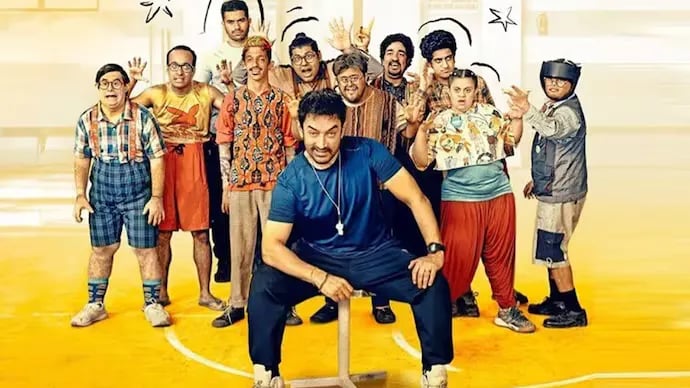Glitter, Gimmicks, and Glaring Gaps: When Inclusion Becomes a Performance
Real actors, unreal storytelling. Shruti Pushkarna dissects Sitaare Zameen Par — a film that confuses visibility with inclusion and turns a powerful opportunity into another exercise in inspiration porn.
7/2/20254 min read


From Taare to Sitaare: Real actors with Down Syndrome, but no real characters. What could’ve been a landmark film becomes another lesson in lazy storytelling.
By Shruti Pushkarna
A lot of people are celebrating Aamir Khan’s latest film, Sitaare Zameen Par. It’s being hailed as a step forward for inclusion. Parents are emotional, the disability sector is cautiously optimistic, and casual moviegoers are moved by the presence of actors with Down Syndrome in a mainstream Bollywood film. Some people I spoke to even said, “At least now we know they’re not paagal (or mental).” That one sentence says everything about why this film is being applauded, and why it worries me.
Because when the bar is set that low, even a flawed, painfully loud, half-baked movie starts to look like progress.
I watched Sitaare Zameen Par last week. I went in with hope. The original Spanish film Campeones (Champions) had stayed with me for its subtlety, its focus on sport and attitudinal barriers, and the refreshing way in which disability was present but not spotlighted as a spectacle. It was warm, funny, human. The disabled characters weren’t there to inspire you — they were just being themselves, with all their quirks and contradictions. That’s why it worked.
Sitaare Zameen Par tries to copy the structure, but forgets the soul. What we get instead is a star-driven mess where everything feels forced — from the humour to the messaging to the very premise. It’s as if someone took Champions, dunked it in a bucket of Bollywood tropes, added a saviour complex, and expected it to pass as inclusion.
Let’s start with the biggest distraction: Aamir Khan. This is not the thoughtful, measured Aamir of Taare Zameen Par. This is the wide-eyed, wild-haired, performative version who grimaces, shouts, pouts, and mugs for the camera like he’s playing an exaggerated theatre character. His portrayal of Gulshan, the disgraced basketball coach doing community service at a vocational centre for neurodivergent adults, is jarring. He’s not guiding the story, he’s devouring it. Every scene is about him, even when it’s supposed to be about the team.
And the team? That’s where the real heartbreak lies. The actors with Down Syndrome are the most authentic part of the film but they’re treated like background props. There’s no character building, no sense of who they are beyond a few clichéd traits. No time is spent exploring how their disabilities shape their play, their strategies, their interpersonal relationships. The film doesn’t trust them or the audience, with complexity. It’s all about inserting wow moments, tugging at heartstrings, and then moving quickly to the next morality lecture.
Basketball, a sport with almost no cultural connect in India, is lifted wholesale from the original without any adaptation. We’re never shown how the players learn, grow, or even function as a team. There’s no gameplay tension, no underdog build-up, no real sporting narrative. Just a rushed montage here, a dance sequence there, and a script that’s so eager to teach life lessons that it forgets to tell a story.
Genelia D’Souza plays Aamir’s estranged wife. Not a social worker, not a coach — just another emotionally convenient character whose presence serves to trigger Aamir’s awakening. Like most of the film, she’s underwritten, and ends up overacting to compensate. There’s also Dolly Ahluwalia, who brings much-needed warmth, but her moments are brief and drowned out by the noise.
And it is noise. The dialogues are clunky. The humour is crass and inappropriate in parts — yet the audience laughed, because the film told them it was funny. Every time someone used a derogatory term like “mental,” the film paused to deliver a public service announcement. That kind of writing doesn’t empower, it patronises.
I’ve said this before, and I’ll say it again: representation is not charity. Visibility is not inclusion. Casting disabled actors is not the same as telling disabled stories. If you want to make a film about people with Down Syndrome, then write real characters. Give them backstories, conflicts, growth arcs. Treat them as more than sidekicks in a star’s redemption arc.
Sitaare Zameen Par is not an inclusive film — it is inspiration porn, repackaged with Bollywood gloss. It reduces disability to a spectacle and leaves no room for the viewer to think or interpret. Everything is over-explained, overstated, overacted.
Some people argue that the film still matters because it’s a starting point. Because now “normal” audiences are curious. Because at least the term Down Syndrome has entered drawing room conversations. Sure. But why must awareness come at the cost of quality? Why must the story be dumbed down to get people to care? Shouldn’t we be raising the bar, and not lowering it?
This isn’t just about one film. It’s about a pattern. After Laal Singh Chaddha, a lifeless remake of Forrest Gump, this is Aamir’s second consecutive misstep — another remake that misunderstands its source material and tries to overcompensate with moral weight. It’s not working.
Compare this to a film like Sparsh — released in 1980 and still miles ahead in sensitivity. Naseeruddin Shah’s blind character doesn’t need dramatic speeches to assert his dignity. It’s in the way he reacts when a waiter hands the cheque to his date. It’s in the silence, the discomfort, the subtext. That’s what cinema can do when it treats the audience with respect.
Sitaare Zameen Par treats the viewer like a child. It delivers its messages with a hammer. It turns real lives into performance. And it sidelines the very people it claims to centre.
So yes, talk about this film. Watch it if you must. But don’t stop there. Ask harder questions. Expect more. Because if this is what representation looks like, then it’s time we demanded better.
The community deserves better. The audience deserves better. And cinema, frankly, deserves a lot more honesty.
P.S. Read my earlier review of Champions and Next Goal Wins here,
https://www.mxmindia.com/columns/shruti-pushkarna-representation-matters-why-is-the-media-limited-to-stereotypical-chronicling-of-diverse-identities/

Let’s Build Something Inclusive.
info@karuneti.com
© 2025. All rights reserved.
Whether you’re rethinking communication, leadership, or workplace culture, Karuneti helps you design with inclusion at the core.
